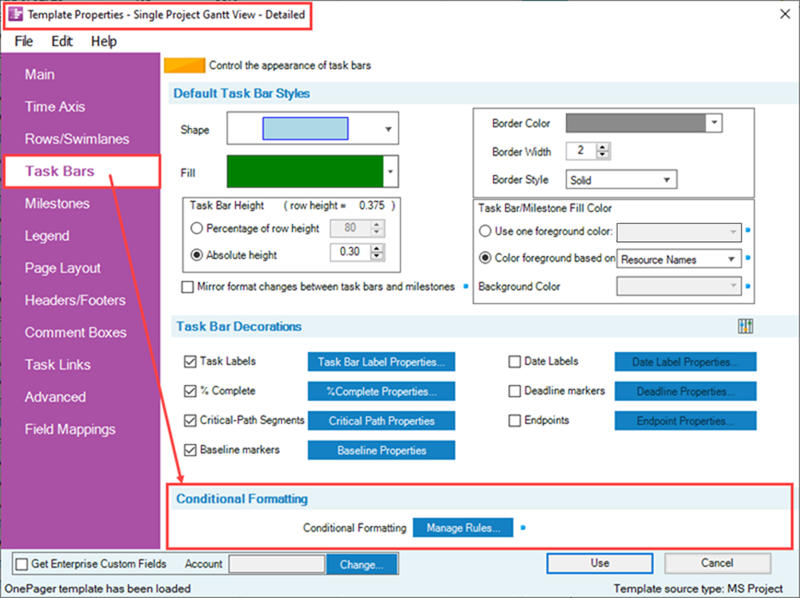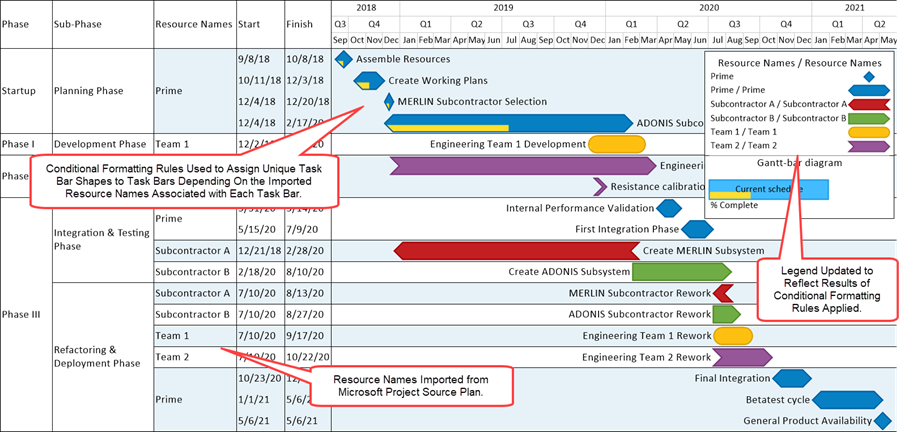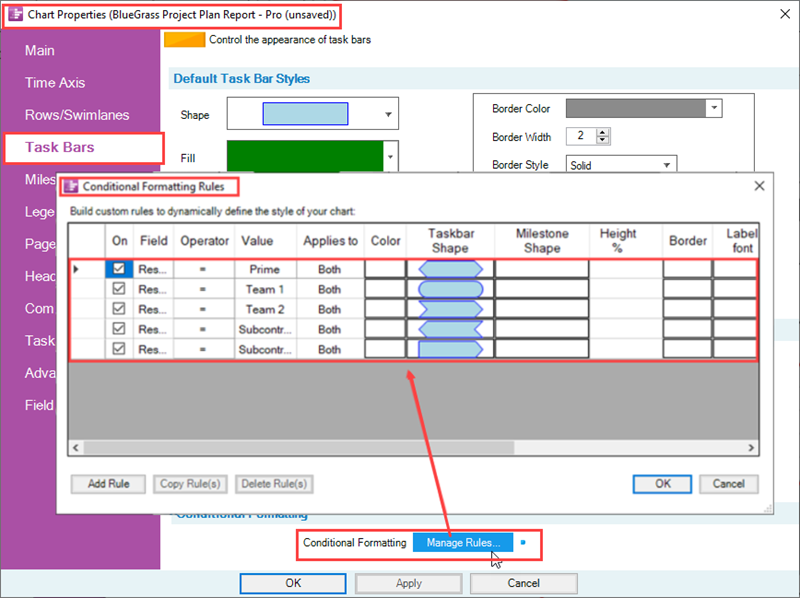Conditional Formatting for Version 7.1 (Portal)
Contents
Introduction to Conditional Formatting in OnePager
This series of article describes OnePager’s Conditional Formatting features. Illustrations used in this article are from OnePager Pro using data from Microsoft Project but the feature's function, controls, and manual edits apply equally to other OnePager editions that import from data sources like Microsoft Excel, Smartsheet, and Oracle Primavera P6.
About Conditional Formatting
Conditional formatting allows you to define a set of rules that alter the look of your chart as the data in your source plan changes.
It goes beyond the dynamic color-coding feature described in the article at: Task Bars Tab 21.3.1-71
The following elements can be defined by using conditional formatting rules:
- Shape (task bar or milestone symbol)
- Color (foreground color and background color)
- Height %
- Border Style
- Label Font Properties
- Label Position
- Legend Text
To go directly to the list of detailed articles for Conditional Formatting for OnePager, click here: Related Links 11.0.1-71
Conditional Formatting Controls
You can define conditional formatting rules either before or after you create new chart. To create rules before you create a chart, use the Template Properties form by navigating to the Task Bars or Milestones tab and navigating to the Conditional Formatting control group as shown below in the OnePager Pro Template Properties form:

Clicking the Manage Rules... button in this control group accesses the Conditional Formatting Rules form where you can add, edit, and delete conditional formatting rules.
Detailed articles are provided to assist you with using the Conditional Formatting feature for OnePager below: Related Links 11.0.1-71
The same Conditional Formatting control group is available in the OnePager Chart Properties form as well as the Template Properties form.
Conditional Formatting Example
As an example, the following chart, used throughout this Wiki, is shown below with the application of Conditional Formatting rules to vary the shapes used for tasks to indicate the Resource Name associated with each task shape shown.

To achieve this result in the chart, below is the simple set of Conditional Formatting Rules used:

Related Links
The articles listed in the table below describe OnePager’s Conditional Formatting feature. Illustrations used in these articles are from OnePager Pro but the feature's function, controls, and manual edits apply equally to OnePager Express and OnePager Bundle.
| Conditional Formatting Overview 11.1.1-71 |
| Adding Conditional Formatting Rules 11.3.1-71 |
| Conditional Formatting with Boolean Fields 11.5.1-71 |
| Managing Conditional Formatting Rules 11.9.1-71 |
| Conditional Formatting Rules and the Legend 11.11.1-71 |
| Conditional Formatting Rules and the Template 11.13.1-71 |
| Summary of Conditional Formatting Actions 11.7.1-71 |
Basic Workflows (Portal) 7.0.1-71
Manual Editing Task/Milestone Shapes and Text Labels (Portal) 9.0.1-71
Modifying Decorations on Tasks/Milestones (Portal) 10.0.1-71
The Chart Legend (Portal) 15.0.1-71
Editing with the Chart Properties form (Portal) 21.0.1-71
Managing Templates (Portal) 24.0.1-71
Glossary of Dynamic Shapes and Emoji Symbols 29.3.1-71
Other Resources
Conditional Formatting Tutorial Video
Blog-Display Certainty in Your Plan by Using Conditional Formatting
Using Microsoft Project Flag Fields with OnePager Pro's Conditional Formatting Rules
(11.0.1-71)